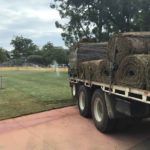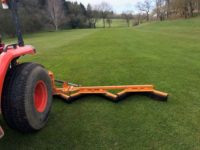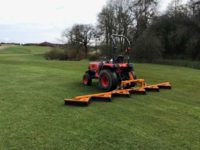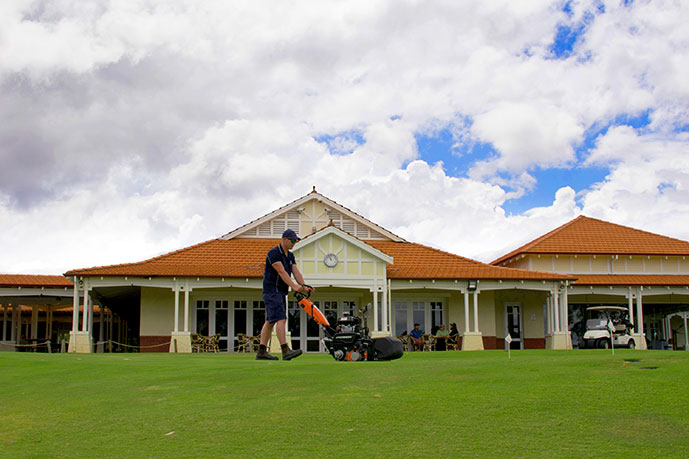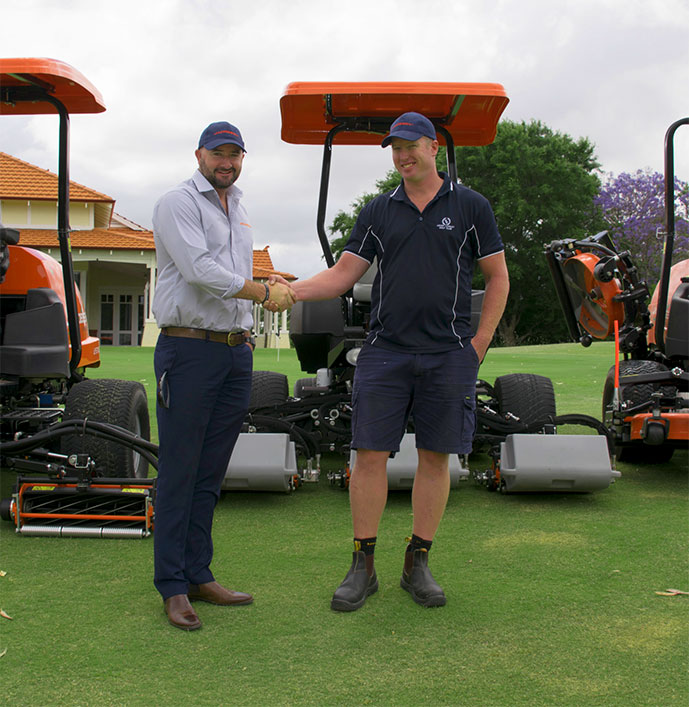Title: Greenkeeping on a budget
Author: Wendy Morris, Greenkeeper, Turf Wicket Maintenance Services
http://turfwicketms.com.au/

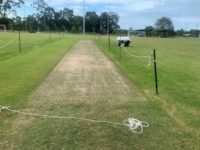

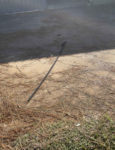

I didn’t intend to become a greenkeeper. Prior to joining the industry, my last foray into the heady world of horticulture was back in the nineties, when I learned the high school agriculture teacher turned a blind eye to student’s smoking so long as when we were asked to work, we worked. I was agreeable to this deal.
Well, that was over twenty years before my husband accidentally ended up with a greenkeeping business (a story for another day), and his sole staff member urgently needed time off. I was happily working a white collar job, but had a frightening amount of annual leave up my sleeve. The answer, it seemed, was obvious and so I traded the computer for a roller and spent the better part of the following three weeks going back and forth, back and forth, back and forth.
Somehow, I ended up on the payroll, obtained a Cert II in Horticulture, completed a spray certificate and went through the tick and flick process of procuring a white card. The office job became a distant memory. Covid saw me half step out of the industry and move part time to production horticulture, but I continued mowing and spraying, fertilisingand advertising, marking and rolling.
After several years I finally felt confident enough to start talking to my industry peers. And that’s when it hit me that we did things very, very differently to many of them. Unlike my husband, who completed his apprenticeship at the Gabba under Kevin Mitchell Junior, I’d been inducted into a very different, much more cost conscious, world.
Our business has always been with local sporting clubs, small to medium sized schools, and the odd private client. Equipment sheds are small, budgets are smaller still. Often our fees are one of the highest expenditure items, outside of uniforms, that a club will face each year. Committees can change annually.
The challenge is not to produce a premium product, but to produce a quality, consistent product in the most time efficient manner possible. We are fortunate in that we receive significant support from club executive’s who largely have no practical experience in greenkeeping but have quickly learnedenough to respond to disgruntled team captains who are unhappy with our wicket selection for the round, and to nod appropriately when we discuss the pythium that’s made an appearance on their wicket after the team ‘forgot’ to remove the covers when the game got called off late Friday night. There isn’t much that beats the support of our client, and we are immensely grateful to all of the volunteers who keep their clubs running.
It is up to us to uphold our part of the bargain and justify our worth, and in between negotiating with dog walkers who don’t see the issue with Fido and Oscar cavorting on the wicket block as we are trying to seal a wicket, we have learned a few tricks to ensure the best possible outcomes.
Here are some of the things we’ve learned.
Maintaining turf coverage is tricky when you have a limited budget, year round cricket, and spikes aren’t worn by all players. Throwing out a bag of urea is cheap and will get coverage up, but consistent use will lead to excess thatchinessand we do not have a single client that owns a scarifier (one doesn’t even own a functional cylinder mower). Further, to keep costs down, we need to keep a close eye on the amount of labour we utilise in maintaining and preparing wickets, andscarifying every two months is not what we consider an effective use of time.
So what’s the alternative? We have had to play around with different products at different grounds, but we consistently find ourselves using a lot of kelp based products. We mix foliars with granulars, and save our premium products for periods where the turf is under high amounts of stress.
When it comes to covering wickets, there is no substitute for firm communication. We are fortunate in that all our clients now own a hessian, a strip cover and a block cover. What many players don’t understand is the cost and relative delicacy of a hessian. We no doubt sound like broken records at times, but ensuring the club is drying and folding the hessian correctly on Saturday morning when the covers come off means we are not begging for a new hessian every nine to twelve months. And asking a club to fold covers your preferred way can also result in significant time savings when it comes to putting covers back on! We remind them that we budget x amount of hours at their Club each week and if we have to spent an hour untangling a mess, then that hour is deducted from their wicket prep.
Machinery maintenance and repairs is another area where costs can skyrocket. This is where we as greenkeepers need to take the five minutes to do a pre start check each and every time and to operate machinery properly and with full care.
My habit of eating breakfast while backing a roller out of the shed seemed harmless until the chain on a roller snapped and two tonnes of steel suddenly picked up more speed than had hitherto been seen out of a Mentay. With a half-eaten breakfast biscuit hanging from my mouth and a can of Pepsi Max precariously balanced on the front of the roller, I realised that if I didn’t divert the roller I was going to slide into a carpark and take out a hatchback.
I searched desperately for a tree to use as a blockade, but there were none in roller-turning-distance. The decision was made to steer the roller onto the road where it would hopefully hit a traffic island and stop. Fortunately, in between my current location and the traffic island was an area where council had recently upgraded the sewer line, and the ground was sitting unusually proud. This was sufficient to stop the roller in it’stracks. It was also sufficient to remind me that if I had to eat while on a roller, I should at least wait until I was on a flat surface!
Irrespective of how well we look after our machinery, it still needs servicing and at some point it will need to be repaired. Newer machines may have specific requirements to ensure that warranties are retained, however it still pays to shop around. It is important that service and repairs are well priced and undertaken within a reasonable time frame. It is no use saving $50 on a repair if the shop you’ve chosen will take an extra three weeks to return your machine.
Developing a relationship with a competent mechanic can be a lifesaver. Our mechanic has pulled our clients out of binds more times than we can count, and as they are independent, they can fix long-out-of-warranty mowers and rollers without demanding we wait three months to have a genuine replacement shipped from the US.
One last point for today – an extra jerry can or two can be the difference between having to buy fuel when you need it, andbeing able to stock up during low price periods. We’ve paid between $1.09/L and $1.749/L for unleaded this year. For a client using 15 litres of fuel a week, the difference between paying an average of $125.9/L and $1.45/L is $150 a year.
This might not be much to a stadium, but for us, it means that our clients can cover the cost of the tent pegs that disappear each year just prior to Easter, a container of Halosulfuron, and a bottle of Bundy for the best low-to-mid budget greenkeepers in Brisbane.















